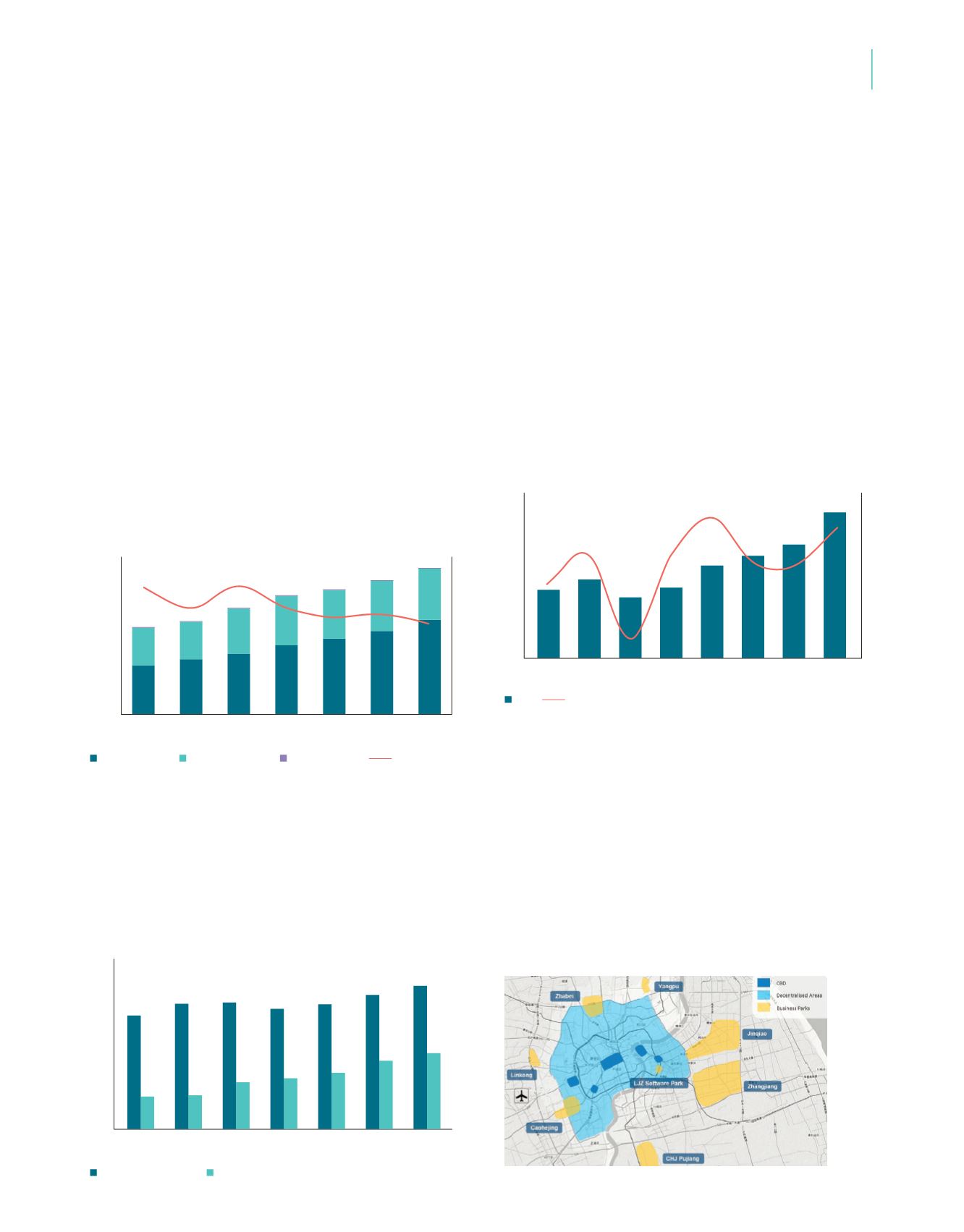
Shanghai’s Foreign Direct Investment (“FDI”) witnessed stable
growth after the drop in year 2009, reaching USD 31.6 billion at
the end of 2014. Shanghai’s FDI grew 26.8 percent year on year as
of the end of 2014. The city has 4,697 FDI contracts, with a total
investment volume contracted at USD 31.6 billion. The proportion
of FDI attributed to secondary industry increased 5.2 percent
year on year, in which industrial sector dropped 4.8 percent year
on year, as a result of manufacturing industries moving out of
Shanghai. Tertiary industry increased 25.4 percent year on year
as Shanghai’s pilot Free Trade Zone attracted more FDI in to the
service industry since its inception in September 2013.
Figure 3: Shanghai Foreign Direct Investment
and its Growth (2007 to 2014)
Source: Shanghai Municipal Bureau of Statistics
2. Supply
Shanghai has eight core business parks, comprising in excess
of approximately 6,927,589 square metres of high-quality
stock as at the end of 2014. Zhangjiang (
张江
) and Caohejing
(
漕河泾
) are both state level high-tech zones and generally
considered to be Shanghai’s prime business park areas, with
established markets, good connectivity to the Central Business
District (“CBD”) and good quality office product. Linkong (
临空
)
and Jinqiao (
金桥
) are considered to be the primary emerging
markets in the Shanghai business parks market
Map 1: Shanghai Business Park Districts
Source: Colliers International Shanghai Research
INDEPENDENT MARKET STUDY (SHANGHAI & BEIJING)
By Colliers International Property Consultants (Shanghai) Co. Ltd.
SHANGHAI BUSINESS PARK
1. Macroeconomic Highlights
Shanghai’s economy maintained steady growth in 2014, albeit
at a lower growth rate than recorded in previous years. The
output of gross domestic product (“GDP”) reached RMB 2.35
trillion by the end of the year, an increase of 7 percent over
the previous year, compared to the 7.7 percent growth seen
in 2013. GDP per capita at the end of 2014 reached RMB
94,768 based on 2013’s population statistics.
The total output value of tertiary industry reached RMB 1.53 trillion,
an increase of 8.8 percent over the previous year, 4.5 percentage
points more than the growth of secondary industry, and becoming
a major factor in stimulating economic growth in Shanghai.
Figure 1: Shanghai GDP and GDP Growth (2008 to 2014)
Source: Shanghai Statistics Bureau
In 2014, Shanghai’s total fixed asset investment rose 6.5 percent
over the previous year to RMB 602 billion. Of this, investment in
real estate reached RMB 321 billion, an increase of 13.7 percent
year on year, representing over half of total fixed asset investment.
Figure 2: Shanghai Fixed Asset Investment
and Real Estate Investment (2008 to 2014)
Source: Shanghai Statistics Bureau
2007
2008
2010
2012
2009
2011
2013
2014
USD Billion
2.0% 14.8% -22.3% 15.1% 31.3% 11.1% 10.3% 26.8%
FDI
FDI Growth
2,500
1,500
2,000
1,000
500
0
2008
2010
2012
2009
2011
2013
2014
12%
6%
10%
4%
8%
2%
0%
RMB Billion
787
609
12
9.7% 8.2% 9.9% 8.2% 7.5% 7.7% 7.0%
12
13
13
12
11
11
893
600
983
722
1,114
793
1,220
785
1,345
803
1,527
816
Tertiary industry
Secondary industry
Primary industry
GDP Growth Rate
700
500
300
100
600
400
200
0
2008
2010
2012
2009
2011
2013
2014
RMB Billion
479
527
532
507
525
565
602
140
146
198
217
238
289
321
Fixed Asset Investment
Real Estate Investment
25
30
35
15
20
10
5
0
30%
40%
0%
20%
-10%
10%
-20%
-30%
17.1
13.3
15.3
20.1
22.3
24.6
31.6
14.9
70 71


